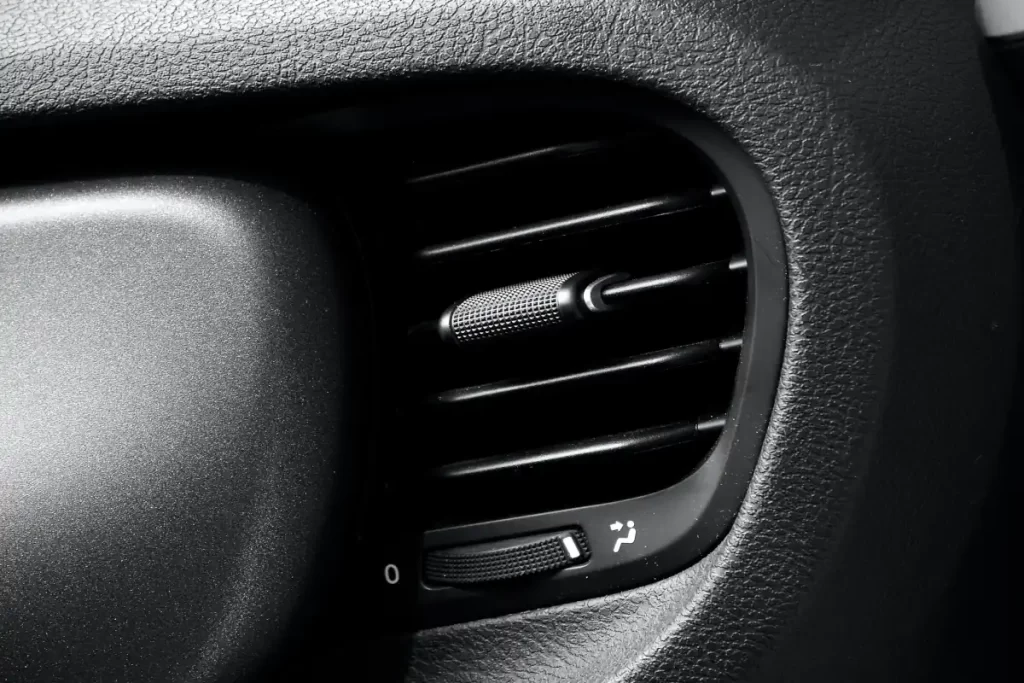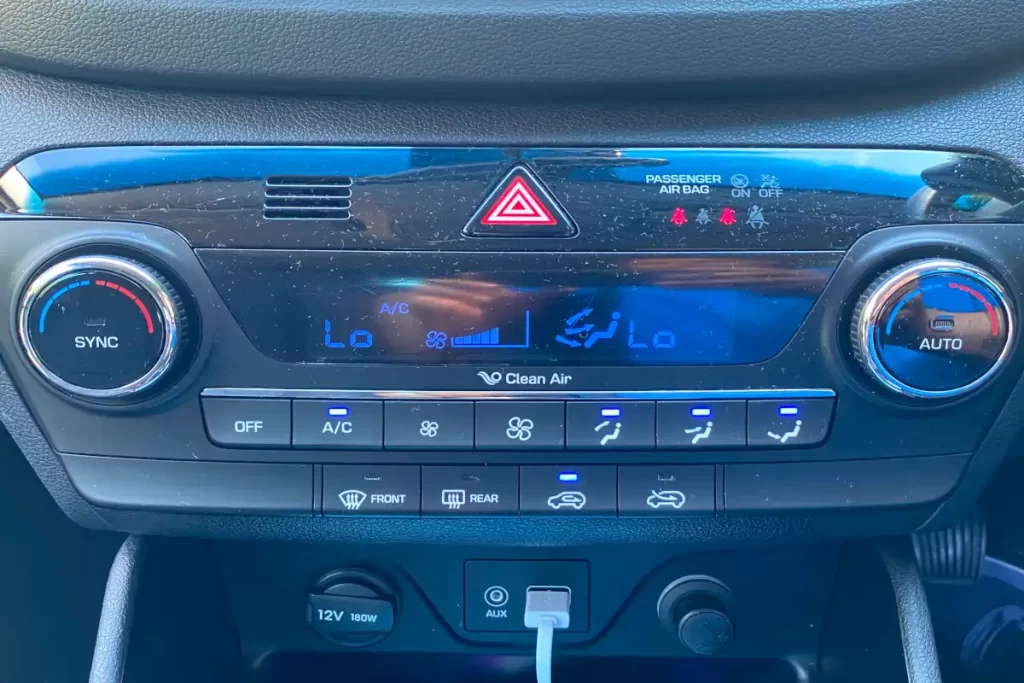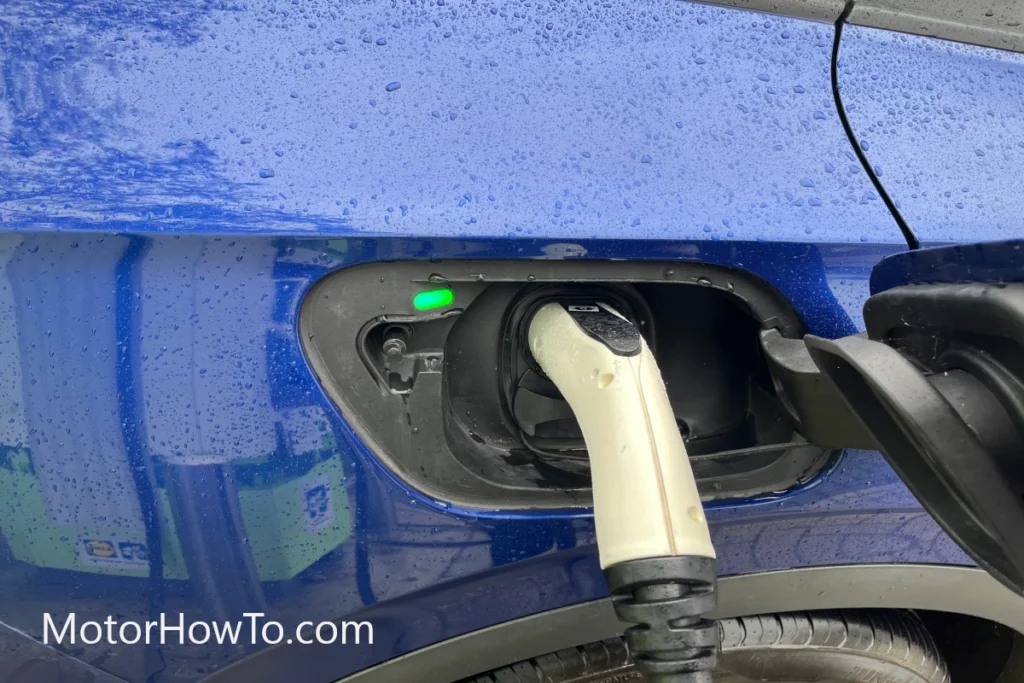Car vents are controlled by one or more actuators, fans, and the vacuum created by the engine.
These parts work together to control where the air is directed if it’s hot or cold, and the airflow volume.
This Is What Controls Vents Airflow In A Car Cabin
Climate control modules in modern vehicles regulate and control the air ventilation system electronically by controlling three or four actuator motors that control the vents. A vacuum servo controls the air vents in older vehicles with a manual control system.
- This Is What Controls Vents Airflow In A Car Cabin
- What Controls The Front Dash Air Vents, Defrost Vents, And Floor Vents?
- What Controls Where Air Blows In The Car Cabin?
- What Controls The Direction Of The Airflow From A Vent?
- How Do I Set The Vent Air Flow To Max and Min?
- Why Is One Of The Vents Not Blowing While The Others Are?
- Final Thoughts
- Sources

While driving, the engine creates a vacuum.
When the car moves, the entry point of the duct is in a high-pressure area, allowing air to be forced into the car from the front. Afterward, the heater warms it if necessary. The top of the car’s hood is another common entry point.
There are vents on the dashboard and in the footwells that allow air into the car’s interior. You can adjust the vents so they face the front-seat passengers.
There are also ducts located behind the rear seat in some cars. A stream of warm air is blown onto the back passengers through slots in the ledge at the bottom, and by the front side windows in later cars.
All entry points on modern cars have flaps that can be opened and closed.
Exit vents are located at the rear of the unit. A constant flow of air occurs as the car moves because they are in a low-pressure area.
Related:
- What Is the Rear A/C Vent In a Car? (Explained For Beginners)
- 5 Reasons Why Car Blows Hot Air When Heater Is Off? (Solved)
- What Is a Cowl Vent or Intake Vent in a Car? (Explained For Beginners)
What Controls The Front Dash Air Vents, Defrost Vents, And Floor Vents?

In addition to controlling defrost, the blend door actuator also controls the mid-vents and floor vents. It is possible to control the climate in different zones in some cars with dual-blend door actuators.
In modern vehicles, the air ventilation system is controlled electronically by three or four electrical actuator motors, which are controlled by the climate control module.
As part of the climate control system, the defroster actuator is controlled by the air position door in the heater, which is controlled by the climate system. Air vents in the middle, lower, and defrosted zones are controlled by this actuator. The defrost position is where it can fail, and it must be replaced when it does.
This defroster is housed inside the heater as part of the air conditioning and heating system. With the blower motor operating, the defroster vent control system is integrated with all temperature controls.
What Controls Where Air Blows In The Car Cabin?
Newer cars use three or four electric actuator motors to control the vent direction and temperature.
A vacuum servo controls these vents and temperatures on older cars with manual controls.
During operation, the engine provides a vacuum. Passengers can also use the vents in the dash to angle the vents to blow in certain directions within the cabin.
What Controls The Direction Of The Airflow From A Vent?
The engine vacuum line in the engine compartment helps control the direction of airflow. It pulls the air in as the car is driving and the engine is running.
The vacuum line will leave the bulkhead at the rear of the engine and head toward the intake manifold. Under the dash, in the center, is a vacuum tank connected to the other end of the line.
How Do I Set The Vent Air Flow To Max and Min?
Each part of your car has a different level or register.
Depending on whether your windshield is fogged or not, you can choose amid the different instrument panel vents, vents on the floor, and defrost vents.
The next step is to decide how hard you want to feel the airflow once you have decided on the temperature and direction. You can control that by changing the fan speed. There may also be fan options in some late-model luxury cars that can soften the airflow while still achieving a high volume.
Setting up the air conditioner vents so that they maximize cooling is easy. Simply open the louvers all the way and aim them at the center of the car. Nevertheless, air conditioning involves more than just lowering the thermostat and opening louvers.
You can also maximize the cooling effects of your air conditioner by increasing air circulation in the cabin.
Passengers also have a little more control over the heat. To direct the heat to the area you want, simply direct your vents there and crank them up to maximum. When a car needs to be heated quickly, recirculating the air can be helpful, as this circulates already heated air instead of cold air that comes in through the engine.
Why Is One Of The Vents Not Blowing While The Others Are?
If your air conditioner’s front vents aren’t blowing out, it may be caused by a clogged air intake system. Air is collected from outside the vehicle and circulated through the air conditioner through the intake system.
The air collection component will be difficult to function if it is faulty or clogged.
Therefore, if the A/C in your vehicle front isn’t working, the air intake system is most likely clogged.
Therefore, ensure that your car’s electrical system is free of blown fuses or bad relays. Getting this issue diagnosed and fixed by an expert auto technician is the best course of action.
It is most likely that the car is running on low refrigerant if one side of the A/C isn’t working. The problem can also be caused by blocked vents, but the most common culprit is low refrigerant levels.
Low refrigerant levels in car air conditioning systems affect temperature circulation across the dashboard from one side to the other automatically. Thus, cold air may be blown from one side of the system while warm air is blown from another side.
In case this happens to you, be sure to consult a professional auto mechanic to check it out and correct it right away. Keep in mind that delay can lead to a serious escalation of a problem.
The following symptoms may indicate that your car’s air conditioning vents are clogged: inconsistent temperature circulation, dust buildup inside vents, overheating, etc.
An air conditioner vent that is clogged will cause the temperature to differ in different areas of the car, resulting in cold areas and hot areas. Taking a close look through the vents may also reveal dust build-up.
It is possible for dust to protrude from the vent in some cases. The HVAC system may also shut down completely if a clogged AC vent is left unattended for a long period of time.
Final Thoughts
To direct airflow for heating and air conditioning, the A/C actuator moves air distribution doors. HVAC box air distribution doors are attached to the A/C actuator underneath the dashboard.
In addition to moving the doors into different positions, the motors can move them between two points at the same time. The ventilation system in a car is made up of many components that work together to circulate air and heat through the vehicle.
Sources
No Air Coming Out of Vents in Car – Reasons & Solution | The Grumpy Mechanic
How Does Mode Actuator Failure Affect Your Car? (markdouglasmotorworks.com)
Car AC Not Blowing Air From Vents ❤️ Everything You Need To Know (cashcarsbuyer.com)



